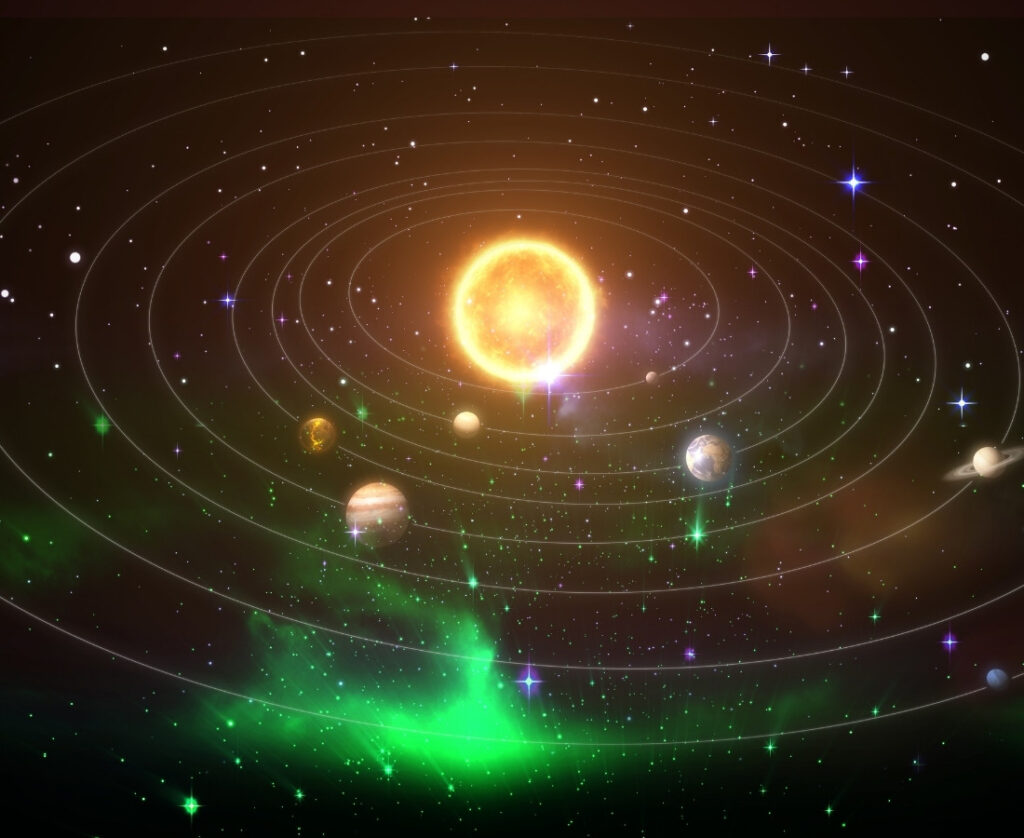Disclosure: This post may contain affiliate links, meaning I get a commission if you decide to make a purchase through my links, at no extra cost for you
How much do you know about the sun? It’s time to test your knowledge of the most famous star of them all with this sun quiz.
It’s made of 5 rounds of 10 questions and answers about the sun. This includes easy, medium and hard trivia as well as a multiple choice round and a true or false one.
Round 1: Easy Sun Trivia Questions

- What kind of celestial body is the sun?
- What is the name of the force that keeps the planets orbiting the sun?
- How many planets orbit the sun?
- Where is Earth in the order of planets orbiting the sun?
- How many days does it take for Earth to complete an orbit of the sun?
- What is the most abundant gas in the composition of the sun?
- The sun orbits the centre of which galaxy?
- What is the nearest star to the sun?
- What is the name for the powerful explosions on the surface of the sun which are responsible for the Aurora Borealis?
- Which Renaissance scientists discovered that the Earth orbits the sun?
Round 1: Easy Sun Trivia Questions and Answers
- What kind of celestial body is the sun? A star
- What is the name of the force that keeps the planets orbiting the sun? Gravity
- How many planets orbit the sun? Eight
- Where is Earth in the order of planets orbiting the sun? Third
- How many days does it take for Earth to complete an orbit of the sun? 365
- What is the most abundant gas in the composition of the sun? Hydrogen
- The sun orbits the centre of which galaxy? The Milky Way
- What is the nearest star to the sun? Proxima Centauri
- What is the name for the powerful explosions on the surface of the sun which are responsible for the Aurora Borealis? Solar Flares
- Which Renaissance scientists discovered that the Earth orbits the sun? Nicolaus Copernicus
Round 2: Sun Multiple-Choice Questions

- What percentage of the solar system’s mass is taken up by the sun?
- 84.4%
- 89.9%
- 94.4%
- 99.9%
- Who was the Greek God of the sun?
- Sol
- Helios
- Zeus
- Hephaestus
- What is the name of the process by which the sun creates energy?
- Photosynthesis
- Heliosynthesis
- Nuclear Fusion
- Nuclear Fission
- How far is the sun from the Earth?
- 75 million km (47 million miles)
- 100 million km (62 million miles)
- 125 million km (77 million miles)
- 150 million km (93 million miles)
- Before it was discovered that the Earth orbits the sun, many people believed that…
- The sun orbited the Earth
- The sun and the Earth orbited Heaven
- The sun and the Earth orbited Jupiter
- Everything in space was still
- How long does it take for light from the sun to reach Earth?
- 45 seconds
- 8 minutes
- 18 minutes
- 80 minutes
- What is the name for the outermost layer of the sun’s atmosphere?
- The Heliosphere
- The Corona
- The Transition Region
- The Chronosphere
- Sunspots are areas of the sun’s surface that are…
- Solid
- Hotter
- Cooler
- More radioactive
- What is the most abundant metal in the composition of the sun?
- Iron
- Zinc
- Nickel
- Magnesium
- At the end of its life cycle, the sun will become…
- A Nebula
- A Supernova
- A Black Hole
- A Neutron Star
Round 2: Sun Multiple-Choice Questions and Answers
- What percentage of the solar system’s mass is taken up by the sun? D. 99.9%
- Who was the Greek God of the sun? b. Helios
- What is the name of the process by which the sun creates energy? c. Nuclear Fusion
- How far is the sun from the Earth? D. 150 million km (93 million miles)
- Before it was discovered that the Earth orbits the sun, many people believed that… a. The sun orbited the Earth
- How long does it take for light from the sun to reach Earth? B. 8 minutes
- What is the name for the outermost layer of the sun’s atmosphere? B. The Corona
- Sunspots are areas of the sun’s surface that are… c. Cooler
- What is the most abundant metal in the composition of the sun? D. Magnesium
- At the end of its life cycle, the sun will become…a. A Nebula
Round 3: Sun Quiz – True or False

- The sun began its life as a nebula.
- The sun is one of around 10 million stars in the Milky Way.
- The surface temperature of the sun is 10 times hotter than the core of the Earth.
- Just like the Earth, the sun also rotates on its axis. One full rotation takes roughly 27 Earth days.
- The second most abundant gas in the composition of the sun is carbon dioxide.
- The Earth does not orbit the sun in a perfect circle, so it is sometimes closer and sometimes further away from the sun.
- A total solar eclipse cannot last longer than 7.5 minutes.
- Just like the centre of the Earth, the sun’s core is made of molten metal.
- The sun is about half-way through its life. It’s currently around 4.5 billion years old and will expand to swallow the earth in around 5 billion years time.
- When the sun expands, Uranus and Neptune will be in the new habitable zone.
Round 3: Sun Quiz Answers – True or False
- The sun began its life as a nebula. True
- The sun is one of around 10 million stars in the Milky Way. False, there are around 10 billion stars in the Milky Way.
- The surface temperature of the sun is 10 times hotter than the core of the Earth. False, in fact scientists now think that the Earth’s core might be hotter than the surface of the sun.
- Just like the Earth, the sun also rotates on its axis. One full rotation takes roughly 27 Earth days. True
- The second most abundant gas in the composition of the sun is carbon dioxide. False, it’s helium.
- The Earth does not orbit the sun in a perfect circle, so it is sometimes closer and sometimes further away from the sun. True
- A total solar eclipse cannot last longer than 7.5 minutes. True
- Just like the centre of the Earth, the sun’s core is made of molten metal. False
- The sun is about half-way through its life. It’s currently around 4.5 billion years old and will expand to swallow the earth in around 5 billion years time. True
- When the sun expands, Uranus and Neptune will be in the new habitable zone. False, but Jupiter and Saturn will be.
Round 4: Medium Sun Trivia Questions

- What is the name for the idea that the sun is the centre of the solar system?
- What kind of star is the sun?
- What kind of star will the sun become in the next stage of its life?
- What is the term for a star which, like the sun, can fuse together hydrogen and helium?
- What is the name for the visible surface of the sun?
- What is the sun’s outer atmosphere made of?
- What is the term for the sun’s magnetic field?
- How long, in Earth years, is the solar cycle?
- During which period of the solar cycle can result in disruption radio transmissions and power grids on Earth?
- What element will the sun ‘run out of’ in around 5 billion years, causing it to enter the next stage of its life cycle?
Round 4: Medium Sun Trivia Questions and Answers
- What is the name for the idea that the sun is the centre of the solar system? Heliocentrism
- What kind of star is the sun? A yellow dwarf
- What kind of star will the sun become in the next stage of its life? A red giant
- What is the term for a star which, like the sun, can fuse together hydrogen and helium? A main-sequence star
- What is the name for the visible surface of the sun? The photosphere
- What is the sun’s outer atmosphere made of? Plasma
- What is the term for the sun’s magnetic field? The Heliosphere
- How long, in Earth years, is the solar cycle? 11 years
- During which period of the solar cycle can result in disruption radio transmissions and power grids on Earth? The Solar Maximum
- What element will the sun ‘run out of’ in around 5 billion years, causing it to enter the next stage of its life cycle? Hydrogen
Round 5: Hard Sun Trivia Questions

- The sun has a density of 1.41 g/cm³, therefore, which planet in our solar system has the most similar density to the sun?
- Who was the first astronomer to suggest that the sun might be a star?
- What is the name of the probe that NASA launched in 2018 to be the first Earth object to ‘touch’ the sun?
- What direction does the sun spin on its axis?
- What is the name of the imaginary line around the sun, past which any object will be pulled apart by the sun’s gravity?
- Which element gets its name from the sun?
- Coronary ejection is when a large piece of what breaks away from the sun?
- The sun emits unstable particles called pions, which decay to become what?
- What is the outermost layer of the sun’s interior?
- Who received a Nobel Prize in Physics in 1967 for discovering how the sun generates energy?
Round 5: Hard Sun Trivia Questions and Answers
- The sun has a density of 1.41 g/cm³, therefore, which planet in our solar system has the most similar density to the sun? Jupiter
- Who was the first astronomer to suggest that the sun might be a star? Anaxagoras
- What is the name of the probe that NASA launched in 2018 to be the first Earth object to ‘touch’ the sun? Parker Solar Probe
- What direction does the sun spin on its axis? Counter-clockwise
- What is the name of the imaginary line around the sun, past which any object will be pulled apart by the sun’s gravity? Roche Limit
- Which element gets its name from the sun? Helium
- Coronary ejection is when a large piece of what breaks away from the sun? Plasma
- The sun emits unstable particles called pions, which decay to become what? Gamma Rays
- What is the outermost layer of the sun’s interior? The Convective Zone
- Who received a Nobel Prize in Physics in 1967 for discovering how the sun generates energy? Hans Bethe
You may also be interested in:
